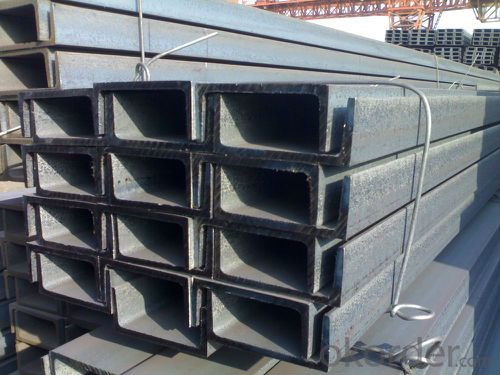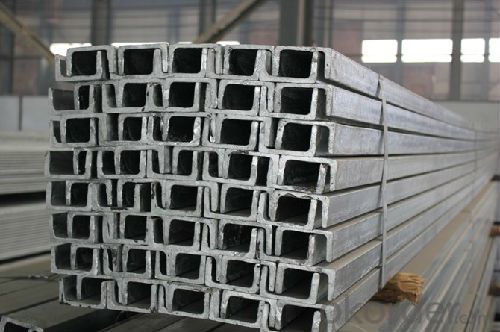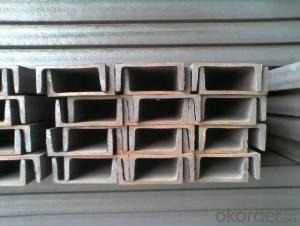Hot Rolled U CHANEEL 5-300mm or High Quality GB OR JIS
- Loading Port:
- China Main Port
- Payment Terms:
- TT or LC
- Min Order Qty:
- -
- Supply Capability:
- -
OKorder Service Pledge
OKorder Financial Service
You Might Also Like
Product Description:
OKorder is offering high quality Hot Rolled Steel I-Beams at great prices with worldwide shipping. Our supplier is a world-class manufacturer of steel, with our products utilized the world over. OKorder annually supplies products to European, North American and Asian markets. We provide quotations within 24 hours of receiving an inquiry and guarantee competitive prices.
Product Applications:
1.The JIS U Channel Steel can be devided into two kinds, namely common channel steel and light channel steel. The sizes of hot rolled common channel steel range from 5# to 40#. Meanwhile, the channel steel can be divided into cold forming sectional equal channel steel, cold forming sectional unequal channel steel, cold forming inner edge channel steel and outer edge channel steel.
2.The JIS u channel steel is usually used for arch-itechtural structure, and they could be welded in order to support or hang a vari-ety of facilities. They are also usually used in combination with I beam. The channel steel with sizes under 14# is usually applied to construction engineering, as purline, while the channel steel with sizes above 16# is more likely to be used in building vehicle chassis structure and mechanical structure. Furthermore, the channel steel in sizes above 30# are target at building bridge structure, as tension bar.
3.In a word, the channel steel must possess perfect welding property, riveting property and mechanical property and so on.
Product Advantages:
OKorder's Steel I-Beams are durable, strong, and resist corrosion.
Main Product Features:
· Premium quality
· Prompt delivery & seaworthy packing (30 days after receiving deposit)
· Corrosion resistance
· Can be recycled and reused
· Mill test certification
· Professional Service
· Competitive pricing
Product Specifications:
Manufacture: Hot rolled
Grade: Q195 – 235
Certificates: ISO, SGS, BV, CIQ
Length: 6m – 12m, as per customer request
Packaging: Export packing, nude packing, bundled
Original Place | Tangshan, China | Brand Name | UINDA |
Standard | JIS G3192 : 1990 | ||
Material Grade | SS490 | ||
Sizes | 50mm to 200mm | ||
Sales Volume/Year | 3000MT | ||
Destination Area | Middle East, Africa, Southeast Asia | ||
2. The sections in details are as followings in the table-1
JIS U CHANNEL | Standard | Sectional | Dimension |
| Mass: |
| (mm) | (mm) | (mm) | (mm) |
|
50x25 | 50 | 25 | 3.0 | 6.00 | 2.37 |
75X40 | 75 | 40 | 3.8 | 7.00 | 5.30 |
75X40 | 75 | 40 | 4.0 | 7.00 | 5.60 |
75X40 | 75 | 40 | 4.5 | 7.00 | 5.85 |
75X40 | 75 | 40 | 5.0 | 7.00 | 6.92 |
|
|
|
|
|
|
100X50 | 100 | 50 | 3.8 | 6.00 | 7.30 |
100X50 | 100 | 50 | 4.2 | 6.00 | 8.03 |
100X50 | 100 | 50 | 4.5 | 7.50 | 8.97 |
100X50 | 100 | 50 | 5.0 | 7.50 | 9.36 |
|
|
|
|
|
|
125X65 | 125 | 65 | 5.2 | 6.80 | 11.66 |
125X65 | 125 | 65 | 5.3 | 6.80 | 12.17 |
125X65 | 125 | 65 | 5.5 | 8.00 | 12.91 |
125X65 | 125 | 65 | 6.0 | 8.00 | 13.40 |
|
|
|
|
|
|
150x75 | 150 | 75 | 5.5 | 7.30 | 14.66 |
150x75 | 150 | 75 | 5.7 | 10.00 | 16.71 |
150x75 | 150 | 75 | 6.0 | 10.00 | 17.90 |
150x75 | 150 | 75 | 6.5 | 10.00 | 18.60 |
150x75 | 150 | 75 | 6.5 | 10.00 | 24.00 |
|
|
|
|
|
|
200X80 | 200 | 80 | 7.5 | 11.00 | 24.60 |
3. The mechanical property of JIS U Channel Steel in the table-2:
Grade | Yield Strength,N/mm² | Extension Strength N/mm² | |||
Thickness of Steel,mm | |||||
≦16 | >16-≦40 | >40-≦100 | >100 | ||
SS490 | ≧285 | ≧275 | ≧255 | ≧245 | 490-610 |
4. The chemical composition of JIS U Channel Steel as per SS490 in the table-3
Grade | Element(%) | |||
C | Mn | P | S | |
SS490 | - | - | ≦0.050 | ≦0.050 |
FAQ:
Q1 Can stainless steel rust?
A1 Stainless does not "rust" as you think of regular steel rusting with a red oxide on the surface that flakes off. If you see red rust it is probably due to some iron particles that have contaminated the surface of the stainless steel and it is these iron particles that are rusting. Look at the source of the rusting and see if you can remove it from the surface.
Q2: How do you package the angle steel when shipping?
A2: All goods are packed in bundles with steel strips and shipped by container or break bulk.
Q3: The products are invoicing on theoritical weight or on actual weight?
A3: We can do it in both manners, according to the customers' request.


- Q:Can steel channels be used for supporting heavy machinery?
- Yes, steel channels can be used for supporting heavy machinery. Steel channels are strong and durable structural components made from steel, which makes them ideal for providing support to heavy machinery. The unique shape of steel channels, with a flat base and two perpendicular sides, offers excellent load-bearing capabilities and structural stability. Additionally, steel channels can be easily welded or bolted together to create a customized support structure that can handle the weight and vibrations generated by heavy machinery. Overall, steel channels are a reliable and commonly used choice for supporting heavy machinery due to their strength, versatility, and ability to withstand heavy loads.
- Q:What is the difference between 12# double channel steel and single channel steel?
- Channel steel is a strip of steel with a cross section. The specifications are expressed in millimeters of height (H) * leg width (b) * waist thickness (d), such as 120*53*5, which means waist height is 120 mm, leg width is 53 mm, waist thickness is 5 mm channel, or 12# channel steel. The same height of the channel, if there are several different leg width and waist thickness, also need to add a, B, C on the right side of the model to distinguish, such as 25a#, 25b#, 25c# and so on.
- Q:What are the acceptance criteria for channel steel?
- The raw material for producing channel steel is carbon or low alloy steel billets with a carbon content of not more than 0.25%. The finished channel steel is delivered by hot forming, normalizing or hot rolling.
- Q:How do steel channels perform in terms of acoustic insulation?
- Steel channels are not typically known for their acoustic insulation properties. Steel, being a dense material, tends to conduct sound rather than absorb or block it. This means that steel channels may not provide significant acoustic insulation on their own. However, their performance can be improved by incorporating additional materials or techniques that enhance soundproofing. For instance, adding insulation material, such as mineral wool or acoustic foam, between the steel channels can help dampen sound transmission. Additionally, using resilient mounting systems or decoupling techniques can further reduce the transfer of vibrations and noise through the steel channels. Therefore, while steel channels alone may not offer substantial acoustic insulation, they can be part of a larger soundproofing strategy when combined with appropriate materials and techniques.
- Q:What about the specification of channel steel?
- The same height of the channel, if there are several different leg width and waist thickness, also need to add a B C on the right side of the model to distinguish, such as 25a#, 25b#, 25c# and other meters.
- Q:What are the different types of steel channel connections for floor framing?
- There are several types of steel channel connections commonly used for floor framing, including welded connections, bolted connections, and shear connections. Welded connections involve joining two steel channels together by melting the ends and fusing them together. Bolted connections utilize bolts and nuts to secure the steel channels together. Shear connections involve connecting the channels using plates or angles to transfer the shear forces between them.
- Q:What are the factors to consider when determining the appropriate width of a steel channel?
- When deciding on the suitable width for a steel channel, various factors need to be taken into account. First and foremost, the load-bearing capacity of the channel is of utmost importance. It is essential for the width of the channel to be sufficient in order to support the anticipated load without any bending or buckling. The weight and distribution of the load, as well as any dynamic forces or vibrations, should be considered when calculating the necessary width. Secondly, the span length or the distance between the supports is a crucial factor. Longer spans require wider channels to offer adequate support and prevent any sagging or deflection. Thirdly, the material properties of the steel channel should be considered. The strength and stiffness of the material have an impact on the required width. Using steel with higher tensile strength or a higher modulus of elasticity may allow for narrower channel widths while still maintaining the necessary structural integrity. Additionally, the intended use or application of the steel channel should be taken into consideration. Different applications may have specific requirements for the width of the channel. For instance, in building construction, the width of steel channels used for beams or columns would be determined by structural design codes and standards. Furthermore, the fabrication and installation processes should be taken into account. The width of the steel channel should be practical for manufacturing, transportation, and installation purposes. It should be feasible to produce the desired width within the capabilities of the steel manufacturer, and it should be manageable to transport and erect the channel at the construction site. Lastly, cost considerations play a role in determining the appropriate width of a steel channel. Wider channels generally require more material, resulting in higher costs. However, using a narrower channel than required may compromise the structural integrity and safety, which may lead to additional costs in the long term. In conclusion, factors such as load-bearing capacity, span length, material properties, intended use, fabrication and installation processes, and cost considerations need to be carefully evaluated when determining the appropriate width of a steel channel. This evaluation ensures that the steel channel maintains its structural integrity and functionality.
- Q:Channel 40 is used as a support leg. How many tons can each bear?
- Bearing capacity determined by strengthThe maximum thickness of the member cross section is 18.00mm, according to GB50017-2003, 3.4.1-1, f = 205.00N/mm2According to GB/T 700-1988 and GB/T 1591-1994, FY =225.00N/mm2According to formula 5.1.1-1,N1 = 1 x F X An = 1 x 205 x 67.54 x 102103 = 1384.49kN
- Q:Can steel channels be used for supporting rooftop gardens?
- Yes, steel channels can be used for supporting rooftop gardens. Steel channels are strong and durable, making them suitable for providing structural support to rooftop gardens and their associated weight. Additionally, steel channels can be customized to meet specific design requirements, providing flexibility in creating a stable and secure framework for rooftop gardens.
- Q:How do steel channels contribute to building adaptability?
- Steel channels contribute to building adaptability in several ways. Firstly, steel channels are highly versatile and can be easily modified and adjusted to accommodate changes in building design or layout. This flexibility allows for easy reconfiguration of spaces, making it possible to adapt the building to different needs or functions. Additionally, steel channels can be used to create structural support systems that can be modified or extended as required, providing the building with the ability to accommodate future expansions or modifications. Overall, the use of steel channels in construction enhances the adaptability of buildings, allowing them to evolve and meet changing requirements over time.
1. Manufacturer Overview |
|
|---|---|
| Location | |
| Year Established | |
| Annual Output Value | |
| Main Markets | |
| Company Certifications | |
2. Manufacturer Certificates |
|
|---|---|
| a) Certification Name | |
| Range | |
| Reference | |
| Validity Period | |
3. Manufacturer Capability |
|
|---|---|
| a)Trade Capacity | |
| Nearest Port | |
| Export Percentage | |
| No.of Employees in Trade Department | |
| Language Spoken: | |
| b)Factory Information | |
| Factory Size: | |
| No. of Production Lines | |
| Contract Manufacturing | |
| Product Price Range | |
Send your message to us
Hot Rolled U CHANEEL 5-300mm or High Quality GB OR JIS
- Loading Port:
- China Main Port
- Payment Terms:
- TT or LC
- Min Order Qty:
- -
- Supply Capability:
- -
OKorder Service Pledge
OKorder Financial Service
Similar products
New products
Hot products
Related keywords




























